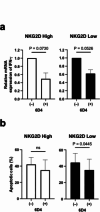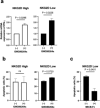MHC class I polypeptide-related sequence B shedding modulates pancreatic tumor immunity via the activation of NKG2DLow T cells
- PMID: 39379424
- PMCID: PMC11461622
- DOI: 10.1038/s41598-024-73712-1
MHC class I polypeptide-related sequence B shedding modulates pancreatic tumor immunity via the activation of NKG2DLow T cells
Abstract
Natural killer group 2 member D ligands (NKG2DLs) are expressed as stress response proteins in cancer cells. NKG2DLs induce immune cell activation or tumor escape responses, depending on their expression. Human pancreatic cancer cells, PANC-1, express membrane MHC class I polypeptide-related sequence A/B (mMICA/B), whereas soluble MICB (sMICB) is detected in the culture supernatant. We hypothesized that sMICB saturates NKG2D in NKG2DLow T cells and inhibits the activation signal from mMICB to NKG2D. Knockdown of MICB by siRNA reduced sMICB level, downregulated mMICB expression, maintained NKG2DLow T cell activation, and inhibited NKG2DHigh T cell activation. To maintain mMICB expression and downregulate sMICB expression, we inhibited a disintegrin and metalloproteinase (ADAM), a metalloproteinase that sheds MICB. Subsequently, the shedding of MICB was prevented using ADAM17 inhibitors, and the activation of NKG2DLow T cells was maintained. In vivo xenograft model revealed that NKG2DHigh T cells have superior anti-tumor activity. These results elucidate the mechanism of immune escape via sMICB and show potential for the activation of NKG2DLow T cells within the tumor microenvironment.
Keywords: ADAM; Immunity; MICB; NKG2D; NKG2DL; Pancreatic tumor; T cell.
© 2024. The Author(s).
Conflict of interest statement
The authors declare no competing interests.
Figures





References
-
- Chen, D. S. & Mellman, I. Oncology meets immunology: The cancer-immunity cycle. Immunity. 39, 1–10 (2013). - PubMed
MeSH terms
Substances
Grants and funding
LinkOut - more resources
Full Text Sources
Medical
Research Materials
Miscellaneous

